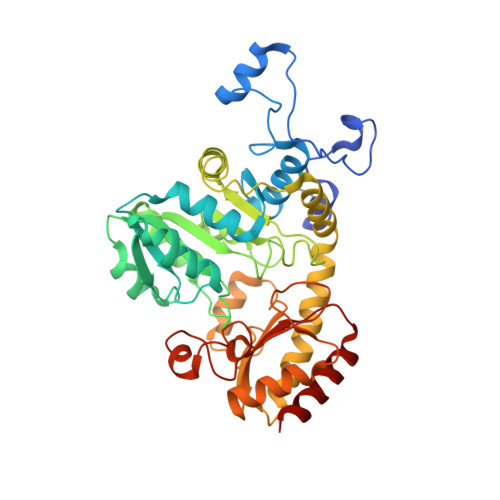Structural and mechanistic insights into homocysteine degradation by a mutant of methionine gamma-lyase based on substrate-assisted catalysis
Sato, D., Shiba, T., Yunoto, S., Furutani, K., Fukumoto, M., Kudou, D., Tamura, T., Inagaki, K., Harada, S.(2017) Protein Sci 26: 1224-1230
- PubMed: 28329912
- DOI: https://doi.org/10.1002/pro.3158
- Primary Citation of Related Structures:
5X2V, 5X2W, 5X2X, 5X2Y, 5X2Z, 5X30 - PubMed Abstract:
Methionine γ-lyse (MGL) catalyzes the α, γ-elimination of l-methionine and its derivatives as well as the α, β-elimination of l-cysteine and its derivatives to produce α-keto acids, volatile thiols, and ammonia. The reaction mechanism of MGL has been characterized by enzymological studies using several site-directed mutants. The Pseudomonas putida MGL C116H mutant showed drastically reduced degradation activity toward methionine while retaining activity toward homocysteine. To understand the underlying mechanism and to discern the subtle differences between these substrates, we analyzed the crystal structures of the reaction intermediates. The complex formed between the C116H mutant and methionine demonstrated that a loop structure (Ala51-Asn64) in the adjacent subunit of the catalytic dimer cannot approach the cofactor pyridoxal 5'-phosphate (PLP) because His116 disrupts the interaction of Asp241 with Lys240, and the liberated side chain of Lys240 causes steric hindrance with this loop. Conversely, in the complex formed between C116H mutant and homocysteine, the thiol moiety of the substrate conjugated with PLP offsets the imidazole ring of His116 via a water molecule, disrupting the interaction of His116 and Asp241 and restoring the interaction of Asp241 with Lys240. These structural data suggest that the Cys116 to His mutation renders the enzyme inactive toward the original substrate, but activity is restored when the substrate is homocysteine due to substrate-assisted catalysis.
- Department of Applied Biology, Graduate School of Science Technology, Kyoto Institute of Technology, Kyoto, 606-8585, Japan.
Organizational Affiliation:

















